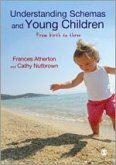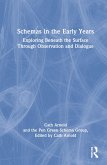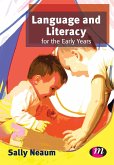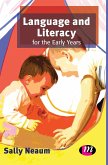Shortlisted for the 2013 Nursery World Awards!
'This exciting book will greatly enhance understanding of learning throughout the early years, and reinforces the importance of responsive professionals who understand children's schemas. Atherton and Nutbrown have brought together socio-cultural and cognitive learning theories with ease, and their metaphors are brilliantly evocative'
-Dr Anne Meade, Consultant
'This book is drawn from a study carried out with rigour and contains several gems, such as the 'bike and slide exploration'; the idea of adults engaging in 'a dialogue of conceptual correspondence' with children; and tables outlining 'what the children might have been thinking'. A great read!'
-Dr Cath Arnold, Pen Green Early Years Centre
'This is an exciting and illuminating account of babies and toddlers, following their schema fascinations with determination and competence, as they continually explore and experiment and come to know their world. This book captivated me. It should be in every early childhood education setting'
-Pam Cubey
This is the first book to focus specifically on Schemas and children under three. The authors trace the development of schemas from motor level through to symbolic representation, and show how to use schema theory to understand young children's learning and behaviour.
This accessible and student-friendly book includes:
-activities and discussion points
-links to policy and practice
-descriptive observational material
-a look at the ethics of this kind of research
-numerous photographs and illustrations
-suggestions for follow-up reading
The book is aimed at early childhood professionals and practitioners in ECEC settings, as well as those on initial training courses, teacher education, Early Years courses, and higher degrees.
'This exciting book will greatly enhance understanding of learning throughout the early years, and reinforces the importance of responsive professionals who understand children's schemas. Atherton and Nutbrown have brought together socio-cultural and cognitive learning theories with ease, and their metaphors are brilliantly evocative'
-Dr Anne Meade, Consultant
'This book is drawn from a study carried out with rigour and contains several gems, such as the 'bike and slide exploration'; the idea of adults engaging in 'a dialogue of conceptual correspondence' with children; and tables outlining 'what the children might have been thinking'. A great read!'
-Dr Cath Arnold, Pen Green Early Years Centre
'This is an exciting and illuminating account of babies and toddlers, following their schema fascinations with determination and competence, as they continually explore and experiment and come to know their world. This book captivated me. It should be in every early childhood education setting'
-Pam Cubey
This is the first book to focus specifically on Schemas and children under three. The authors trace the development of schemas from motor level through to symbolic representation, and show how to use schema theory to understand young children's learning and behaviour.
This accessible and student-friendly book includes:
-activities and discussion points
-links to policy and practice
-descriptive observational material
-a look at the ethics of this kind of research
-numerous photographs and illustrations
-suggestions for follow-up reading
The book is aimed at early childhood professionals and practitioners in ECEC settings, as well as those on initial training courses, teacher education, Early Years courses, and higher degrees.
'I am very excited about this book. It fills many gaps: the age group focused on, the integration of theory with observations of schema learning, effective learning and teaching in play settings.
Atherton and Nutbrown have followed in the footsteps of other important researcher-theorists in studying young children in depth over a long period of time (18 months). They listened intently to what seven children were 'telling' them about their patterns of thought whilst attending a day care setting - including without spoken language to begin with. The authors demonstrate that babies and toddlers are "astonishing thinking things" when adults get to know them differently through observing their play from a schematic perspective.
Dozens of detailed observations of schematic development are provided that enrich practitioner and academic understanding of how very young children learn. The authors integrate
theoretical and research knowledge following each observation by precisely matching quotations from Athey, Piaget, Rogoff, Gardner or other learning theorists with the point the child has demonstrated about learning. Atherton and Nutbrown "walk their talk" albeit at an academic level. In discussing the role of practitioners in early years settings, they assert the need for precise matching of adult talk to the children's thinking concerns and challenge practitioners to provide a conceptual response to children's thinking - and they mean concepts that many would expect from school learning. They provide practical and specific illustrations of how this can be done in connection with the main forms of thought that babies and toddlers demonstrate as they explore the material world.
With socio-cultural learning theory gaining prominence in the field of early education, attention to children learning about schema and mathematic and scientific concepts declined for a time. I am confident that this book will reverse that. Atherton and Nutbrown have brought together socio-cultural and cognitive learning theories with ease in their synthesis of the literature, in theorising the schema stories about the children, in providing "stories of the characteristics of effective learning", and in stories about strengthening children's dispositions and understanding of the world. Their metaphors are brilliantly evocative; for example, adults should be "learning accomplices" of children showing "compatible like-mindedness".
This book will greatly enhance understanding of learning throughout the early years, not just of babies and toddlers, and reinforces the importance of responsive professionals who understand children's schemas. It details how communication with family members at home enhances the opportunities for matched learning encounters between adults and children'
-Dr Anne Meade, Consultant
'This book makes a welcome and valuable contribution to the recent literature on young children and schemas. It strengthens and supports findings of earlier studies and focuses on a younger age group. It is drawn from a study carried out with rigour and contains several 'gems', such as 'the bike and slide exploration'; the idea of adults engaging in 'a dialogue of conceptual correspondence' with children; 'attuned accompaniment' and tables outlining 'what the children might have been thinking'. A great read!'
-Dr Cath Arnold, Pen Green Early Years Centre
'This is an exciting and illuminating account of babies and toddlers, following their schema fascinations with determination and competence, as they continually explore and experiment and come to know their world.
A most valuable resource not only for early years practitioners working with the youngest children, but also for those responsible for the over threes, indeed, for anyone desiring to learn more about using the schematic approach.
The complex skills of the "attuned matched learning encounters" between adults and children and the vital partnership between practitioners and parents are woven throughout the report.
This book captivated me. It should be in every early childhood education setting'
- Pam Cubey
Atherton and Nutbrown have followed in the footsteps of other important researcher-theorists in studying young children in depth over a long period of time (18 months). They listened intently to what seven children were 'telling' them about their patterns of thought whilst attending a day care setting - including without spoken language to begin with. The authors demonstrate that babies and toddlers are "astonishing thinking things" when adults get to know them differently through observing their play from a schematic perspective.
Dozens of detailed observations of schematic development are provided that enrich practitioner and academic understanding of how very young children learn. The authors integrate
theoretical and research knowledge following each observation by precisely matching quotations from Athey, Piaget, Rogoff, Gardner or other learning theorists with the point the child has demonstrated about learning. Atherton and Nutbrown "walk their talk" albeit at an academic level. In discussing the role of practitioners in early years settings, they assert the need for precise matching of adult talk to the children's thinking concerns and challenge practitioners to provide a conceptual response to children's thinking - and they mean concepts that many would expect from school learning. They provide practical and specific illustrations of how this can be done in connection with the main forms of thought that babies and toddlers demonstrate as they explore the material world.
With socio-cultural learning theory gaining prominence in the field of early education, attention to children learning about schema and mathematic and scientific concepts declined for a time. I am confident that this book will reverse that. Atherton and Nutbrown have brought together socio-cultural and cognitive learning theories with ease in their synthesis of the literature, in theorising the schema stories about the children, in providing "stories of the characteristics of effective learning", and in stories about strengthening children's dispositions and understanding of the world. Their metaphors are brilliantly evocative; for example, adults should be "learning accomplices" of children showing "compatible like-mindedness".
This book will greatly enhance understanding of learning throughout the early years, not just of babies and toddlers, and reinforces the importance of responsive professionals who understand children's schemas. It details how communication with family members at home enhances the opportunities for matched learning encounters between adults and children'
-Dr Anne Meade, Consultant
'This book makes a welcome and valuable contribution to the recent literature on young children and schemas. It strengthens and supports findings of earlier studies and focuses on a younger age group. It is drawn from a study carried out with rigour and contains several 'gems', such as 'the bike and slide exploration'; the idea of adults engaging in 'a dialogue of conceptual correspondence' with children; 'attuned accompaniment' and tables outlining 'what the children might have been thinking'. A great read!'
-Dr Cath Arnold, Pen Green Early Years Centre
'This is an exciting and illuminating account of babies and toddlers, following their schema fascinations with determination and competence, as they continually explore and experiment and come to know their world.
A most valuable resource not only for early years practitioners working with the youngest children, but also for those responsible for the over threes, indeed, for anyone desiring to learn more about using the schematic approach.
The complex skills of the "attuned matched learning encounters" between adults and children and the vital partnership between practitioners and parents are woven throughout the report.
This book captivated me. It should be in every early childhood education setting'
- Pam Cubey








